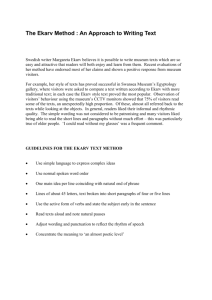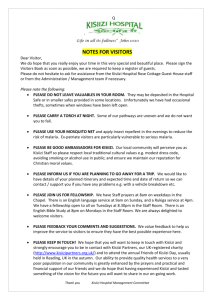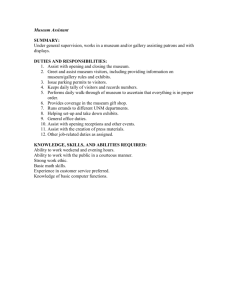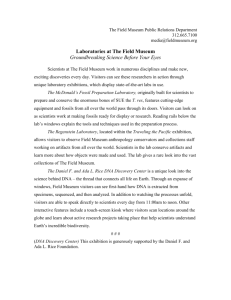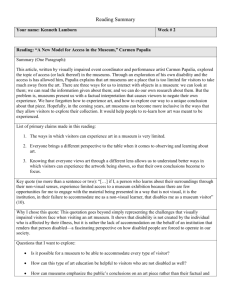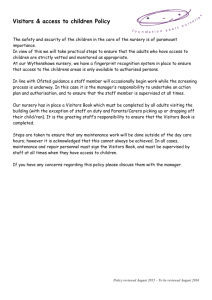Writing text
advertisement
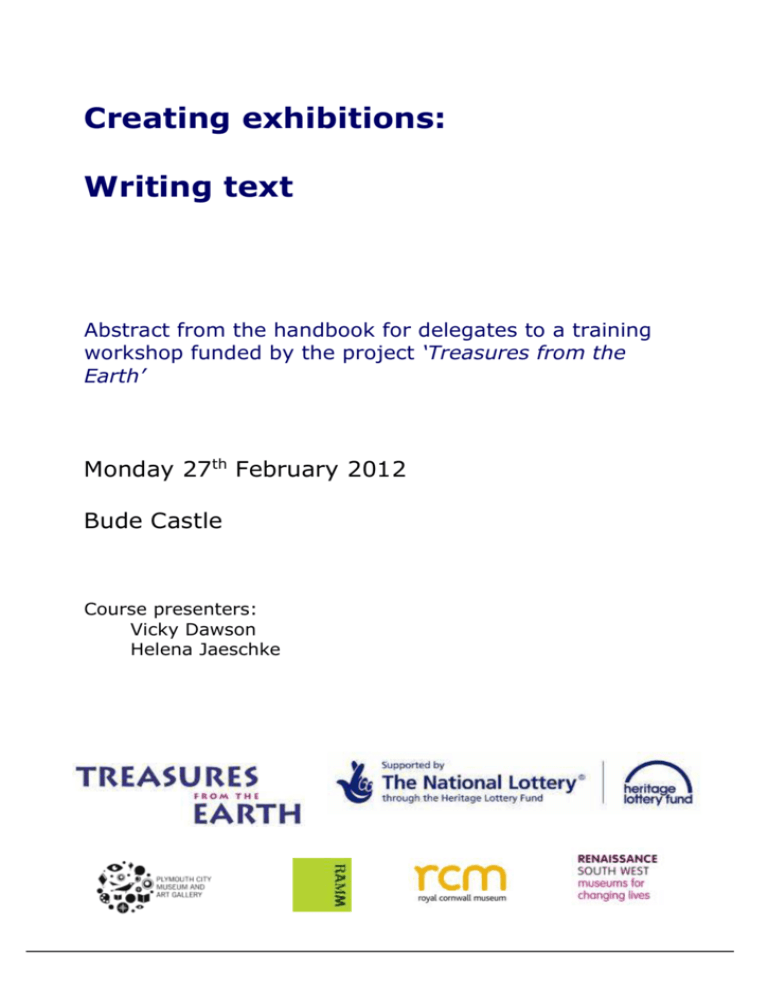
Creating exhibitions: Writing text Abstract from the handbook for delegates to a training workshop funded by the project ‘Treasures from the Earth’ Monday 27th February 2012 Bude Castle Course presenters: Vicky Dawson Helena Jaeschke Writing the script - content ‘Any label, any form of interpretation, is only valid if it makes visitors look again at the object it interprets and with greater understanding.’ Julian Spalding ‘Without a big idea .. Interpretive labels contain fragmented unrelated facts with emphasis on providing information for the sake of information. They also lack soul – the fundamental meaningfulness that answers the question – so what?’ Beverley Serrell Making graphics intellectually accessible – 13 writing tips 1. Decide on a reading age. For general audiences aim at a reading age of 12 for introductory text and up to 15 for subsequent levels. 2. Use main headings or titles to text panels to attract people’s attention. 3. Keep sentences simple, concise and direct. 4. Avoid complicated sentence structures and sub-clauses within commas. 5. Use active verbs eg: ‘Mrs Powys asked Marjorie to lunch,’ not ‘Marjorie was asked to lunch by Mrs Powys.’ 6. Break down lengthy or complicated text into digestible sections. Layer information from the general to the more specific. Use subheadings. 7. Insert short quotations or colloquial expressions if they will add interest or variety to the main text. 8. Avoid jargon or technical terms in text for non-specialist audiences. 9. Ask questions of visitors to help draw them into the display (‘What do you think the..? or Can you guess what..?) 10.Refer to specific visible (or other sensory) qualities of objects such as their size, texture or colour, or make comparisons with other objects to encourage visitors to use their powers of observation. 11.Try to relate descriptions and information to visitors’ everyday experience. 12.Remember that text panels are not books, and cross-references to other panels or to catalogue or object numbers are unlikely to be followed up by visitors. 13.Ask your colleagues to read and comment on drafts – editing your own text is notoriously difficult Page 2 of 7 The Ekarv Method : An Approach to Writing Text Swedish writer Margareta Ekarv believes it is possible to write museum texts which are so easy and attractive that readers will both enjoy and learn from them. Recent evaluations of her method have endorsed most of her claims and shown a positive response from museum visitors. For example, her style of texts has proved successful in Swansea Museum's Egyptology gallery, where visitors were asked to compare a text written according to Ekarv with more traditional text; in each case the Ekarv style text proved the most popular. Observation of visitors' behaviour using the museum's CCTV monitors showed that 75% of visitors read some of the texts, an unexpectedly high proportion. Of these, almost all referred back to the texts while looking at the objects. In general, readers liked their informal and rhythmic quality. The simple wording was not considered to be patronising and many visitors liked being able to read the short lines and paragraphs without much effort - this was particularly true of older people. 'I could read without my glasses' was a frequent comment. GUIDELINES FOR THE EKARV TEXT METHOD o Use simple language to express complex ideas o Use normal spoken word order o One main idea per line coinciding with natural end of phrase o Lines of about 45 letters, text broken into short paragraphs of four or five lines o Use the active form of verbs and state the subject early in the sentence o Read texts aloud and note natural pauses o Adjust wording and punctuation to reflect the rhythm of speech o Concentrate the meaning to 'an almost poetic level' Page 3 of 7 TRADITIONAL TEXT BISHOPSTON BURCH BARROW At Fairwood Common, Gower. Excavated by Mrs Audrey Williams in 1941 A.942.1.1 Ref: Arch. Camb. 1944, pp.52-63 The primary burial was found in a pit which had been cut two feet deep into the subsoil. This contained the cremated remains of a child (a) of 10-14 years of age, covered by an inverted urn (b). Over the base of the urn a thin slab of limestone, roughly 22 ins. Square, had been placed. A cairn 40ft in diameter covered the pit. This cairn was concealed by a mound of mixed clay and turf. It contained traces of secondary burials. Fragments of four cinerary urns (c), all of 'overhanging rim' type, were found towards the centre of the cairn. EKARV TEXT BISHOPSTON BURCH BARROW This barrow is on Fairwood Common in Gower. It was excavated in 1941 when the Fairwood Aerodrome was being built. The first body buried on the site was a child about 10 to 14 years old. It was placed in a small pit under a cinerary urn. Over the urn was a slab of limestone covered by a circular mound of stones. At a later date this was covered by a larger mound of clay and turf. When the barrow was excavated, the archaeologist found traces of other burials and pieces of four cinerary urns. Page 4 of 7 Readability There are a number of formulae used to calculate the readability of text. The Gunning Fog Index is one. Others, together with automated calculation tools can be found at http://www.readabilityformulas.com/gunning-fog-readability-formula.php Page 5 of 7 Session 4 - Graphics Numbers of words Title Attention grabbing headline paragraph Main text broken up into manageable chunks Image and object captions 1 to 5 words 50 words max 50 words per paragraph. between 25 and 50 words Size of typeface – suggested sizes Title Attention grabbing headline paragraph Main text broken up into manageable chunks Image and object captions 60 40 36 18 point + point point point minimum Making graphics physically accessible Avoid decorative fonts except possibly for main headings Decide location of text panels early on to get the size right. Try sample text out in the gallery before making a final decision. Choose a sans serif font (Ariel and Verdana are widely used). Use white or off-white background and black or other dark colour type. Never use pastel shades or yellow ink. Use only left justified text. Do not use UPPER case, bold or italic text except for a brief title or for emphasis. Hyphenation of words at the end of lines reduces legibility and reading speed. Do not superimpose text on a background graphic. Avoid materials for text or backgrounds with a gloss finish which can cause glare or reflection. Adjust lighting to shine on text and avoid shadows. Position panels and labels at standard height and in consistent relationship to objects. Mount labels at 90o to the line of vision. Page 6 of 7 Bibliography, credits and web links Martin, D., Display Text, Museum Practice 5, Museums Association 1997 Martin, D., Interpretation: an introduction, Museum Practice 5, Museums Association 1997 Various authors, Exhibition labels, Museum Practice, published online by the Museums Association, 17.10.2011, www.museumsassociation.org.uk Handouts produced by Rebecca Mileham and Dea Birkett from the TextWorkshop (©) training days. www.textworkshop.co.uk Handouts produced by freelance designer Mike Moore The Campaign for Plain English produces useful guides and even offers an editing service - http://www.plainenglish.co.uk/free-guides.html National awareness days: http://www.projectbritain.com/specialdays.htm Page 7 of 7
